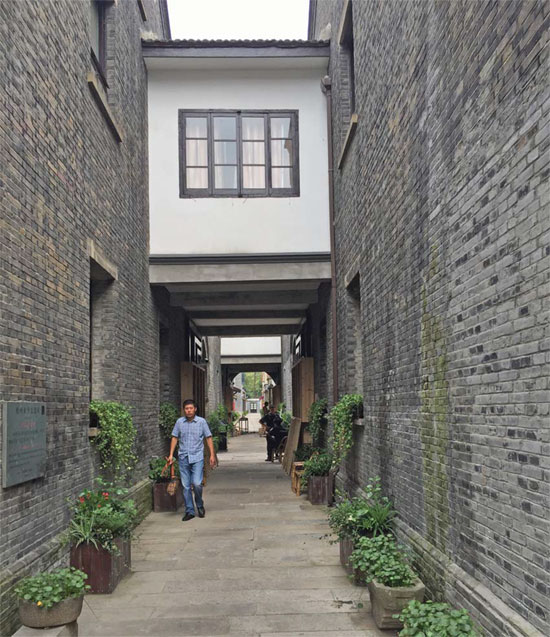Something old, something new

An ancient neighborhood in Hangzhou strives to balance tradition and modernity
It's a distinctive cluster of low-slung historical buildings, tucked away from the hustle and bustle of the West Lake area in Hangzhou, capital of Zhejiang province.
Minutes ago, I was wandering around the commercial hot spots nearby, where skyscrapers wearing Starbucks, Gap and Apple logos hug the streets. Now, two-story structures of black bricks with dark wooden doors framed in stone have sprung up before me.
| Sixinfang community in Hangzhou has centuries-old black-brick structures. A restoration project last year helped the neighborhood retain its historical and cultural glamour. |
| Right: Luo Youming, 71, has lived in Sixinfang all her life. She is considering taking the government's offer to relocate to a new and bigger home. Photos by Yang Feiyue / China Daily |
It's quiet. These centuries-old buildings stretch neatly in all directions of the Sixinfang community in Shangcheng district.
Lou Youming is preparing lunch in a tiny, shabby kitchen right at the entrance of one building as I explore the network of lanes. She steps out from the kitchen when I say hello.
The 71-year-old looks hale and hearty. Lou has lived here all her life.
She invites me in and points to a wooden ladder on the right as we pass the kitchen. "Other households take the ladder to get upstairs," she says.
Her place is on the ground floor - a long, dim, narrow lane leads to a roughly 20-square-meter room where she lives with her husband. A fridge, a TV and a few pieces of old-fashioned furniture are crammed into the room.
Three households live in the building and share the same door.
The old couple enjoys their daily routine. They go to the lake twice a day. It's a five-minute walk away.
"We'll normally get up at 5 in the morning and walk around the lake for two hours," Lou says, smiling. They'll do it again late in the day.
Sixinfang has roughly 220 households, and many residents, like Lou, have lived there for a long time.
The site was a military garrison during the Qing Dynasty (1644-1911) before being purchased by Chen Xingong, a rich merchant, in the 1920s.
Chen remodeled the place after the fashion of Shanghai's shikumen, the stone-framed gatehouses, which integrated some Western elements. Thus he became one of the first realtors in Hangzhou.
The whole community covers an area of about 10,000 sq m. In its heyday, it housed the rich and powerful.
Over time, Sixinfang's inhabitants changed from the rich to ordinary residents. Things took a downturn after the 1980s.
"The planned economy shifted toward a market economy, and high buildings began to emerge all around," Lou says. "People working in those buildings needed to have lunch, so many small restaurants opened."
That was the start of a problem. Most of those catering businesses were illegal and poorly equipped, producing sewage flows as well as a suffocating cooking smoke that shrouded the entire neighborhood.
"We closed our windows and doors and didn't dare to come out," Lou recalls.
She used to get up early to hang out her washing, then take it inside before noon when the restaurants started cooking, and hang it out again after the lunch rush.
Over time, the buildings developed leaky roofs, blocked sewage systems and termites.
Things only began to look up early last year. The local authority set up monitoring outposts in the community to ensure those restaurants don't pop up again.
"The problem was persistent because restaurant owners would reopen their business once we left," says Wang Weishi, a publicity officer for the Sixinfang community.
The authority has also restored the neighborhood, rewired the electrical network and built sanitary restrooms, Wang adds.
All exterior improvements are basically finished, and interior work on the buildings will begin this year.
The idea is to restore Sixinfang's charm and weave it back into Hangzhou's historical and cultural fabric, Wang explains, adding that help from cultural experts may be needed.
Now, a bookstore exhibiting works by prominent locals has opened, along with a free museum.
Lou says the government may offer residents two choices soon: continue to live there and have their homes' interiors upgraded or take a government offer to relocate.
"I'm considering taking the new place, as it would be new and bigger," Lou says.
The downside for her is that the new housing is a bit farther away from her beloved West Lake.
"It's so beautiful and all natural, with blue skies and white clouds," she says. "I'll visit it more now, as I may not be able to see it every day in the future."
yangfeiyue@chinadaily.com.cn
(China Daily Africa Weekly 10/07/2016 page21)
Today's Top News
- Cooperation between China, region becomes increasingly important
- Along ancient Silk Road, Xi cultivates stronger bonds with Central Asia
- Sino-Kazakh cooperation strengthened
- Sino-Uzbek agro-cooperation fruitful
- Retail sales surge points to strong resilience
- Intensified Mideast conflict spurs calls for de-escalation































